Drops and scuffs are common incidents when you’re a bike rider. It’s part of the deal. But dropping your motorbike while loading it, you would want to avoid that. That’s because bikes are heavy, and dropping it might lead to your physical injury.
Even if you avoid getting hurt, the bike itself will be susceptible to damages which will cost you hundreds of dollars.
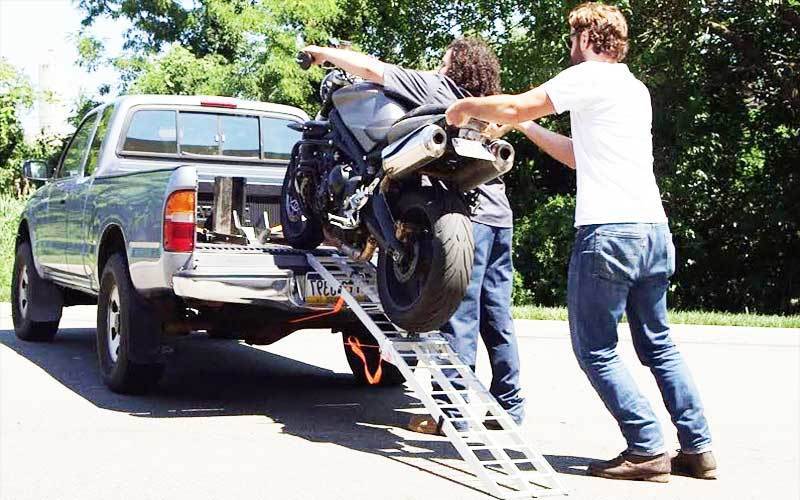
You can evade these scenarios altogether if you spend a little time learning the basics. Once you know how to load a motorcycle into a truck by yourself, you won’t get any sweaty palms, jerking knees, and the whole process will be a piece of cake.
Equipment You Need
- Motorcycle ramps with straps.
- Additional straps like ratchet strap/ soft loop tie down.
- Wheel stand/ chock
.
Loading Motorcycle Into Lifted Truck (Step By Step)
Once you load the bike, The tie-down techniques can vary depending on the model. But for loading procedure, the general principles are almost the same for all models. We have discussed the principles step by step to help you clearly understand the process. So, keep reading.
Step 1: Finding An Incline
To me, this is one of the most important steps to load a bike. Depending on how you handle this step, you can make climbing with the bike super hard or easy.
Why is this important? Because when you find a slope, you’ll be able to tower the height of the truck bed. This will reduce the slope angle and allow you to push the bike with lesser effort.
There are many ways for you to find an incline. Just take a look around. Usually, you’ll find a low point where the edge of the street meets the edge of the driveway. The road is arched at the meeting point to facilitate a drainage system.
You can pull your rear wheels to that point. Make sure to set the parking brake so that the truck doesn’t move.
You might not find an inclination like this always. But, you can work around things and make one of your own. Park the truck near any mound. Here it is, an inclined path to load down the bike instead of pushing up.
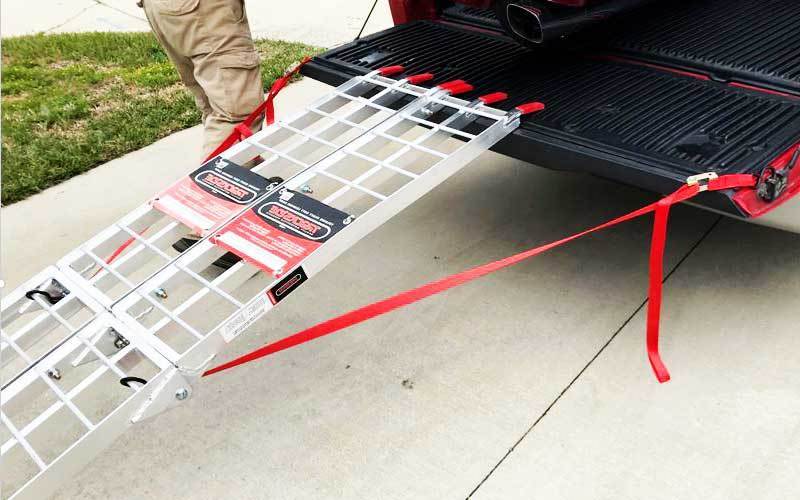
Step 2: Setting Up The Ramp
Before setting up your ramp, make sure you’ve purchased the right one. Many people mistakenly use straight ramps. While they are pretty good to use, if your bike has low ground clearance, the bottom of your bike will collide with the ramp. One way to avoid this is to use arched ramps.
The next step is to attach the ramp firmly with the truck. Most of the manufacturers provide straps. You can either use them or purchase a more secure ratchet strap to tie the ramp.
Do not just depend on resting the ramp fingers on the truck bed. Once you start loading, the weight of the bike or the flexing of the suspension can move the ramp and make things dangerous. Always make sure both ends of the ramp are stable and in harmony with the surface.
Another important thing is the width of the ramp. Surely using a compact ramp is convenient, but you need sure footing while loading the bike. If you find the space too narrow to walk as you climb the ramp, you’re in for a disaster. That’s why use a wide ramp or two identical single ramps so that you can walk right alongside your motorcycle.
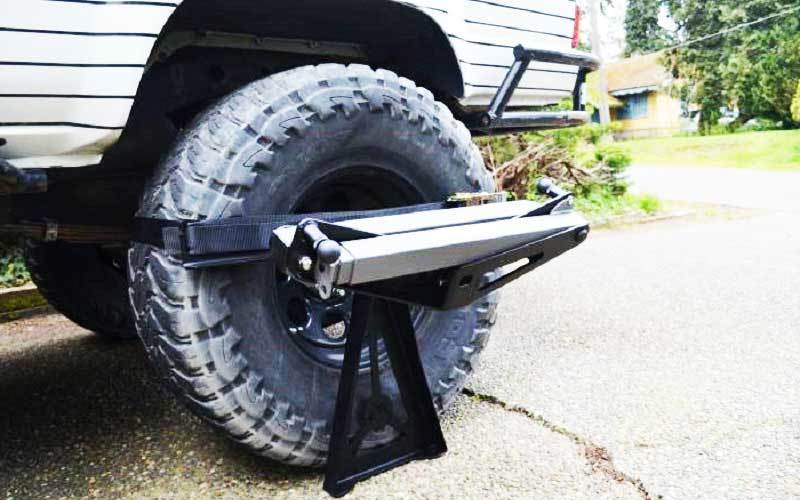
Step 3: Setting Up The Wheel Stand
You need to set the wheel stand before you load the motorbike. Once the bike is loaded, there won’t be enough space for you to move around. Make sure the ramps and the bike is in a straight line with the wheel chock. Usually, the bike is placed at the center of the truck bed unless you want to keep the ramp aside it.
The wheel needs to be heavy enough to hold your bike in place. Usually, a 20 pound chock will do a fine job. There are lighter chocks there which need to be mounted with the truck bed. But honestly, I don’t like drilling my truck bed and will use a true wheel chock instead.
Also, the chock should have a swiveling ramp installed in it. Once you load the bike wheel on the chock, the swiveling ramp will instantly lock it in place.
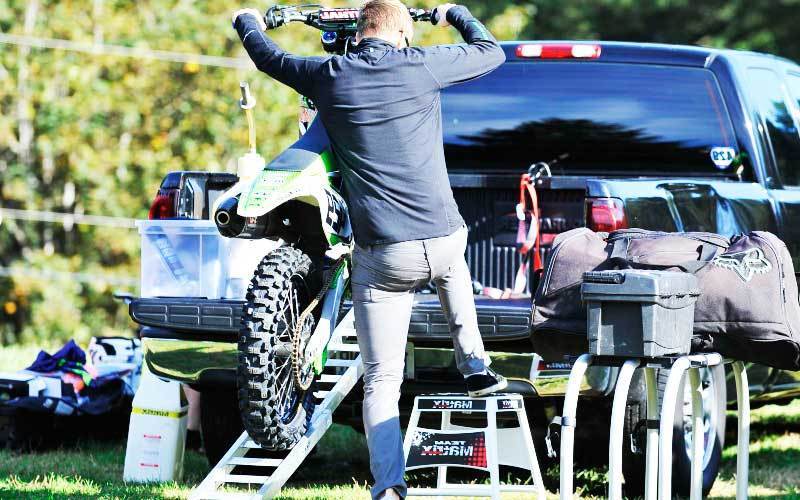
Step 4: Loading The Bike (Manual Or Motor?)
Now, the preparation is done, and this is the time for the final battle. You’re going to load the bike, but the question keeps popping on the head, bike power or pure manual work?
To be honest, it depends on the bike. If the bike is light one like a dirt bike or sports bike, you can pretty much move it by manual force. As for heavier bikes like touring or cruiser bikes, a little motor power is welcome.
If you tell about personal preference, I think pushing the bike by myself is the better course of action. This way, the movement, and velocity is predictable and controllable. If you have set the ramps properly, the loading process is easier than it sounds.
Of course, we’re talking about loading the bike alone. If you have someone friendly nearby, take help. There’s nothing to be ashamed of taking help from a friend.
If you decide to use some of the motor power, you can climb the ramp keeping the throttle and clutch open. The bike will assist up to a level in the loading.
There are special cases where you need the horsepower from the bike. If you’re looking for loading a motorcycle into a moving truck, you’ll have to sit on the bike and ride through the ramp.
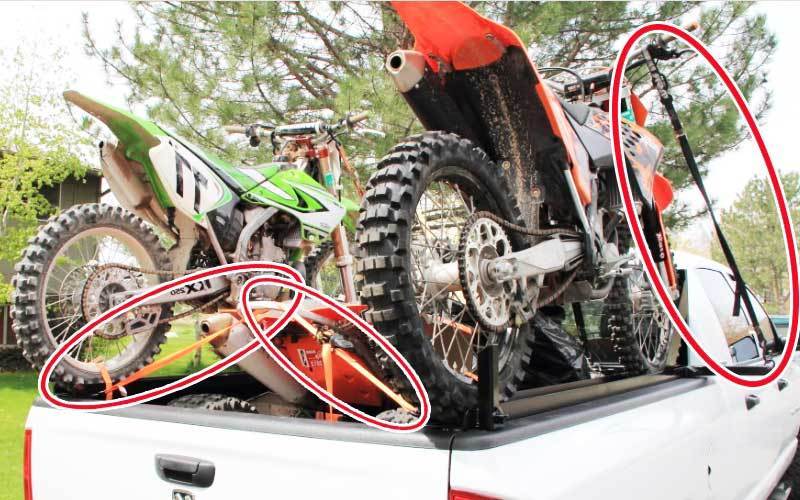
Step 5: Tying And Securing The Bike
Now, you’re done for most parts. The final thing remains for you to do is strapping the bike as it stands on the wheel lock.
You see, you’ll be moving at great speed with your truck. So you should be ready for any equipment failure and always arrange backup measures.
If you’re using wheel chock, a pair of tie-downs will be enough to further secure the bike. Use both of them on the opposing sides of the front wheel.
As for the back wheel, you can use another tie down strap. But personally, I think bed extender is a better option. It serves as an obstacle if the bike somehow comes loose.
You can tie the straps on the bar if the bar is one unbroken piece (like dirt bikes). If the bars are clip-on types (like the ones on sports bike), tying straps can break them. In these situations tie-down the forks or triple clamps.
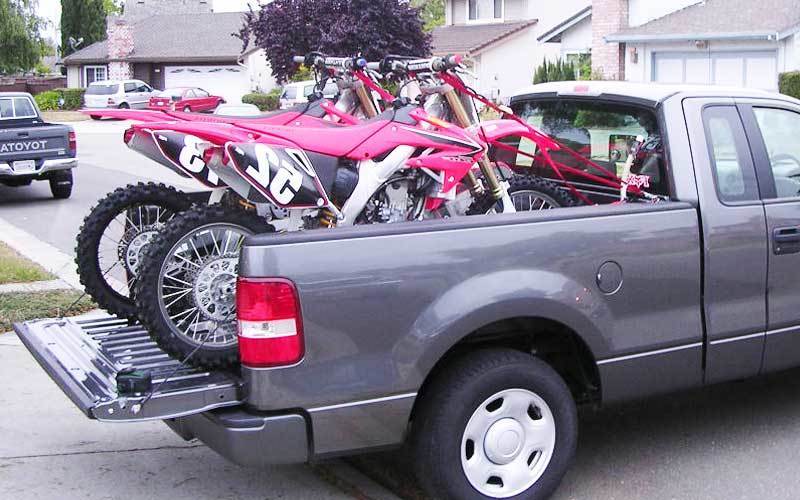
Some Tips For Easy Loading And Security
- Be Patient: Do not run on the ramp. Making a high-speed entry on the ramp can shift the ramp ends from the truck bed. Instead, walk slowing but surely as you climb with the bike.
- Ramp Positioning: Some people tend to keep two narrow ramps side by side to form a wider ramp. Unless you’re tying them together, this approach is risky. As you start climbing, they’ll get separated due to the weight and the front wheel will drop. It’s better to use narrow ramps at a distance.
- Undercarriage Clearance: Make sure you have enough clearance on the bottom of the bike. If the bike has low clearance, the belly of the bike will hit the tailgate of the truck as you climb. If that happens, you’ll need a longer ramp and more forgiving angle.
- Be Balanced: When you tighten the straps, make sure you strike a balance between fastening them too loose or too tight. One way to understand the balance is to tighten the straps until the suspension is half compressed. Any tighter might result in damaging the suspension, and any looser might rescind the purpose of tying.
- Be Sensible: YouTube is full of fail videos of people who tried to ride the bike towards the truck bed without thinking practically. Usually, it’s a highly risky method. If you need some motor power, use clutch/throttle control instead.
- Use Padding: Tying up straps might lead to scratches on your bike. To avoid this, you can use thick papers, or soft towels as padding. If you have to keep your ramp alongside the bike, make sure to put a blanket between two.

Wrapping Up
That’s all about how to load a motorcycle in a truck by yourself. Remember, the best policy is to stay careful and double check everything.
After you’re done loading the motorcycle and tying the straps, walk around the truck and make sure nothing on the bed is moving or wobbling.
If you’re carrying additional items like stands, ramps or gearboxes on the bed, make sure to secure them with bungee cords or straps.
With proper equipment and strategy, loading a motorcycle should be an easy job. Just make sure you’re not hastening and leaving things to chance. Make a proper plan and execute with composure. After everything is done, you can hit the road with peace of mind, knowing nothing is wreaking havoc in the behind.

